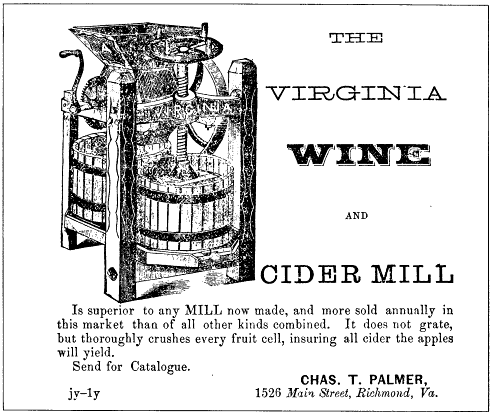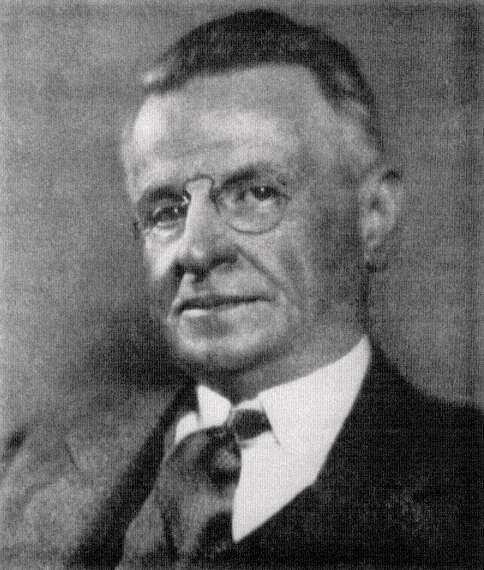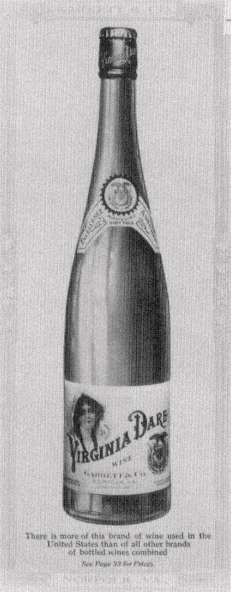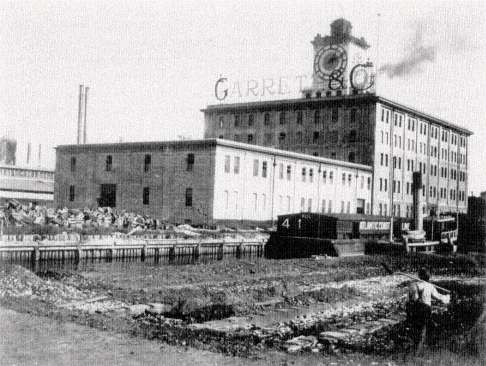The South
In the Southeast, as in the Southwest, the general picture in the period after the Civil War was one of widely scattered local enterprises in grapes and wine. The South had much to contend with: the economic and political disruptions of the war and Reconstruction, obviously; but besides that, the destructive effects of cotton culture, the bad old system of tenant farming, the backwardness of methods, and the poverty of things generally made any new venture precarious. And quite apart from economics and politics, the South was a place where nature itself had many kinds of bad news for grapes: humidity, heat, black rot, downy mildew, powdery mildew, anthracnose, Pierce's Disease, phylloxera, nematodes—after running the gauntlet of that list of afflictions, few vines that people wanted to grow for wine were likely to be left alive. Nevertheless, people did persist, and the conclusion one finally draws from the record is that the hope of making a success of winegrowing is indestructible, no matter what the obstacles and the defeats. What follow are examples of this general proposition.
In Florida, for instance, a state largely developed after the Civil War by an influx both of dispossessed southerners and of northerners looking for sun and land, there was a small sort of grape boom in the last thirty years of the century. The northerners, clustered around Orlando in the middle of the state, tended to plant the labrusca varieties; the southerners, in the north and panhandle of the state, were loyal to their native muscadines. By the 1890s, the high point of grape planting, there were about five hundred acres in the region of Orlando. Florida made 20,000 gallons of wine in 1890; by 1900 the figure was 31,000 gallons.[36] Much of what was made doubtless went unreported, however, for the muscadine growers in the north of the state were rarely more than household winemakers, a circumstance that probably has been true in the South almost from the beginning. By the end of the century, despite modestly rising production figures, it was clear that the northerners' idea that labrusca varieties would prosper in the humid warmth of Florida was a mistake. Inevitably, Catawba and Concord succumbed to
fungus diseases, while the invulnerable muscadines continued to spread vigorously over the rambling trellises that supported them. Florida winemaking went on as it had begun; that is, as a domestic affair usually based on the possession of only a very few muscadine vines. Commercial production was carried on at the Ponce de Leon Wine Company of St. Augustine, which had a winery at Moultrie.[37]
One grower of distinction did emerge from Florida's brief affair with the grape. This was Emile Dubois, of Tallahassee, who was respected enough to be among the wine judges at the Chicago Exposition of 1893 and whose produce from his San Luis Vineyard of Cynthiana and Norton varieties was good enough to win a medal at the Paris Exposition of 1900. But Dubois was, ultimately, compelled by endemic diseases to give up his Florida vineyards, in common with less notable growers.[38]
Alabama, to take another sample of the South, might very well have developed a small, steady trade in wine but for the obstruction of prohibition. Two small colonies on Mobile Bay, named Daphne and Lambert, were founded in the 1890s for Italian immigrants by an Italian-American newspaper editor from Chicago named Alessandro Mastro-Valerio. Both colonies grew grapes and made wine as part of their general plan to make a living from truck gardening and fruit growing. The wine made in these small communities had some success in the markets of Mobile, but local prohibition put an end to viticulture in the pine lands along Mobile Bay.[39]
An entity called the Alabama Fruit Growing and Winery Association was incorporated in 1894 to exploit 20,000 acres in Cleburn County, in the northeastern part of the state along the Georgia border. This was a speculation headed by investors from the Chautauqua grape belt in New York State, including Garrett Ryckman of the Brocton Wine Cellars. The New Yorkers hoped to promote immigration to the district and to develop fruit growing through a cooperative scheme. They named the town on their property Fruithurst, and by 1896 the planting of native grapes—Ives, Delaware, Concord, Niagara, and other familiar varieties better suited to the North than to the South—was under way. Fruithurst attracted a good many settlers, among them a group of Scandinavians. At least one winery was built and wine produced, but marketing difficulties, the shadow of prohibition in the South, and, above all, the native vine diseases had made the enterprise uneconomic by the turn of the century.[40] In 1898 another outfit, called the Alabama Vineyard and Winery Company, promoted a property called Vinemont in the north central part of the state.[41] The hamlets of Vinemont and Fruithurst remain on the Alabama map, but these undertakings, so far as I can learn, have left no other trace and are interesting chiefly as evidence of the persistent glamor of the idea of winegrowing, even where history was not encouraging and local sentiment positively hostile.
In South Carolina, where the tradition of experiment with winemaking goes back to the beginnings in the seventeenth century and where, as we have seen, a great variety of men had tried a great variety of different approaches to the challenge, things were not much different than in the rest of the South. The vineyards
at Aiken, established with such buoyant hope shortly before the Civil War, were still there afterwards, but the heart and means to develop them seem to have disappeared.[42] In the seventies there was a brief burst of activity in grape growing in a new region, the Piedmont area around Greenville in the far northwestern corner of the state. Here, it had been discovered, was a favored spot, a "thermal belt," where the climate just suited the grape and where, for a time, the quickly established vineyards yielded immense crops. Then, in the late eighties, black rot appeared and grape growing faded away.[43] A good instance of the optimism that prevailed for a time around Greenville is a M. Carpin, who came from France, where he had been a viticulturist, to the neighborhood of Greenville in 1876, determined, he said, to "make a wine farm on the French plan." He bought a hundred acres of hilly woodland, cleared it, and set out a mixture of native vines—Norton, Clinton, Concord, Ives, Martha, and Pocklington among others. By the end of a decade he had a vineyard of 80 acres and plans for 150 more; his wine production was 40,000 gallons annually, all of it disposed of through a Boston firm and most of it consisting of a dry red blended wine called "Bordeaux." Carpin himself, it was reported, was "much better pleased with the results of his labor than he ever was in France," and would "listen to no suggestions of failure."[44] Whether Carpin in the event did fail I do not know. Bordeaux mixture may well have arrived in time to save him (South Carolina was one of the first places where it was tried in this country),[45] but its effect was not powerful enough to preserve the Greenville area as a permanent center of winegrowing.
There were more positive developments in the South, too, though they were never quite uncomplicated or straightforward. In Virginia, for example, it might have seemed for a time that the spirit of Jefferson redivivus was at work. For there, in Jefferson's old territory in Albemarle County, grape planting and winemaking had been started afresh immediately following the Civil War. Just after the war, the Virginia farmers, with slavery gone, were forced to find a new basis for their work, and were desperately looking for different crops from those that they had used to grow. Grapes for wine were one of the first suggestions to be made: an advertisement in the American Agriculturist for July 1865, for example, invites investment from interested parties in a scheme for winegrowing in Virginia and North Carolina. This was within three months of Lee's surrender at Appomattox Court House. One of the places where vineyards actually were planted was at Charlottesville, and, as so often was the case, the pioneer was a German. William Hotopp, a native of Germany then residing in Hudson, New York, came south immediately after the war, in 1866, and bought land near Charlottesville on which he planted vines. Other Germans followed him, and by 1870 Hotopp ventured to build a winery.[46]
In 1873 a much larger enterprise, the Monticello Wine Company, was founded by a group of farmers led by another German, Oscar Reierson. The company built a four-story winery of 200,000 gallons' capacity to handle its native wines, and in only a few years was able to obtain awards at international expositions—such awards were apparently required of any American winery seeking respectability.

119
Advertised in The Southern Planter of 1875. this "wine and cider mill" shows that winemaking
was still alive in Virginia, though such crusher-presses no doubt saw many more apples than grapes.
The Monticello Wine Company picked up its obligatory prizes at Vienna in 1876 and at Paris in 1878.[47] Charlottesville wine was largely sold in the New York market, and trade was brisk enough so that by 1888 there were 3,000 acres of vines planted in Albemarle County and a Grape Growers' Association had been formed.[48] The local boosters proclaimed Charlottesville the "Capital of the Wine Belt of Virginia," a modest enough boast, and no doubt true.[49]
An advertisement for the Monticello Wine Company in 1888 lists its products as delaware, catawba, Norton, cynthiana, clinton, Ives seedling, Virginia claret, "Extra Claret," and brandy.[50] Other establishments in the new Virginia wine industry presumably grew more or less the same varieties and made comparable wines. Among those others were Frash & Company in Orange County, Heineken & Peters in Prince William County, and Fritz Baier in Nelson County. In 1890 Virginia recorded a wine production of 461,000 gallons, fifth among all the states. And
then the crash. The numbers for 1900 were a pitiful 38,000 gallons.[51] In 1910 Virginia reported nearly 50,000 gallons of wine produced, far behind such states as Iowa, North Carolina, Arkansas, and Indiana.[52] What had happened? Diseases, as always, were part of the answer; trade depression another part; and competition from California yet another. Finally, and probably most destructive of all, came the growing encroachments of local prohibition, culminating in a statewide measure in 1914. The combination was too much, so that the sources of Virginia wine dried up, not to be renewed until very recent years.
North Carolina, like its neighbor state to the south, had long been the scene of varied experiments aiming to prove that the state could have a profitable wine industry. Some of this experimenting continued to be carried out on a purely fanciful basis, with costly results. A Swiss named Eugene Morel, a pupil of the great French viticultural scientist Jules Guyot,[53] settled near Ridgeway, North Carolina, in 1870, convinced, as he later ruefully recalled, that the vinifera varieties of central and southern France would certainly do well there. He persuaded a group of French settlers to join him, and together they planted 100,000 cuttings of Aramon, Mourvèdre, Grenache, Carignane, Cinsaut, Mourastel, and Clairette vines. Five years later the failure was obvious. A penitent Morel moved on to California, where he employed his skills as a winemaker first in the Napa Valley and then, before his early death from tuberculosis in 1884, in Fresno for the pioneer vineyardist Robert Barton.[54]
When the French viticultural expert J.-E. Planchon visited North Carolina in 1873 he found considerable interest in winegrowing, stimulated by Morel's plantings at Ridgeway (Planchon was rightly skeptical about them). The successful vineyards, he observed, were given over to Scuppernong, and some of these were quite substantial plantings. Everywhere, however, he noted that the winemaking methods and machinery of the state were "entirely primitive."[55]
North Carolina's great success after the Civil War had direct links to a successful antebellum enterprise. The vineyards of Sidney Weller at Brinckleyville, where Weller had carried on a prosperous winemaking business for three decades before the war, were bought in 1867 by two brothers named Garrett.[56] They continued the winegrowing that Weller had begun, selling both still and sparkling wines, mainly from Scuppernong, the rotundifolia variety whose wine Thomas Jefferson had favored early in the century. In 1877 the firm was joined by Paul Garrett (1863-1940), the son of one of the Garrett brothers, and its transformation began. Paul Garrett was evidently born to be a salesman, and since wine was given him to sell, sell it he did. His ability to sell was so far in excess of the winery's ability to produce that he eventually left it to operate on his own as Garrett & Company, founded in 1900.[57] At first he contracted to sell New York State wines as well as those of North Carolina, but he soon determined to concentrate his efforts on the wine from the Scuppernong grape of his native state. He was inspired to call his most popular Scuppernong wine Virginia Dare, after the first child born to English
settlers in this country, on the island where the Scuppernong vine itself was supposed to have originated.[58] So popular did Virginia Dare become, in fact, that its sales outstripped the supply of Scuppernong grapes. Garrett had constantly to exhort the farmers of North Carolina to plant more to feed his presses, and when his efforts fell short of his needs he had to resort to changing the formula: Virginia Dare may have begun as a pure Scuppernong wine, but as its popularity grew so did the volume of bulk California wine that Garrett was forced to add to it. In the end, it had only enough Scuppernong juice in it to "tincture the flavor."[59] Only less popular than Virginia Dare were other Scuppernong wines called Minnehaha and Pocahontas. Garrett also made wines from other native varieties, a claret from Norton and Ives grapes, for instance; but these were by the way.[60]
Ironically, Garrett's growing success was matched by the growing power of prohibitionist sentiment in North Carolina. As district after district voted to go Dry, Garrett escaped the net by moving his operation over the line to Norfolk, Virginia, in 1903. There, in an imposing five-story winery, the fresh juice of North Carolina grapes was turned into Virginia Dare wine. But the dessication of the South continued its inexorable spread, and Garrett was forced in 1912 to move again, this time to Penn Yan, in the Finger Lakes of New York.[61] By then he had expanded and broadened his operations in many ways, with large interests in wineries and vineyards in all the major winegrowing states: California, New York, Missouri, and Ohio, as well as in the muscadine-producing states of the Southeast. Thus, as the sources of the Scuppernong grapes with which he had made a national reputation progressively shrank, and as he had to move his operations farther and farther from their point of origin, his business persisted in growing. The eve of Prohibition found Garrett presiding over a complex of winegrowing establishments with a storage capacity of 10,000,000 gallons. But the North Carolina part of this empire was by that time only a minor territory.[62]
Garrett was not the only producer of native wines in North Carolina, only the most successful. 'In the 1870s wineries specializing in Scuppernong wines were founded at Whiteville, in the southeastern corner of the state, and at nearby Wilmington. The Bear Winery, also at Wilmington, flourished in the late nineteenth century, and by 1912 had reached a capacity of 200,000 gallons a year, mostly muscadine.[63] Fayetteville was another active center of winegrowing, dominated by the Tokay Vineyard of Colonel Wharton Green, whose hundred acres of vines yielded twenty to thirty-five thousand gallons of wine each year. The colonel made wine not only from the Scuppernong but from a varied mix of native grapes: some of the wines were labelled simply Dry Red, Dry White, Sweet Red, and Sweet White; others carried varietal names, such as Norton's Seedling and Delaware.[64] Around Raleigh there were some substantial vineyards, as there were also in the far western corner of the state at Tryon.[65] In 1893 the State Horticultural Society officially reported that the winemaking of North Carolina had "grown greatly in the past few years;"[66] it seems likely that if the growers had not been beset by Prohibition

120
Starting from a small North 120 Carolina winery that went back to Sidney Weller in the 1830s,
Paul Garrett (1863—1940) eventually became the most successful of eastern winegrowers before
Prohibition. His Virginia Dare wine, based on the native Scuppernong grape of the South, became
the most popular of American wines. (From Clarence Gohdes, Scuppernong: North Carolina's
Grape and Its Wines [1982])

121
A bottle of Paul Garrett's Virginia Dare wine, from a company brochure
published around 1913. The quantity of Scuppernong juice in the blend
grew steadily less as the sales of the wine outstripped the ability of southern
growers to supply the grapes, Virginia Dare, for whom the wine was named,
was the first English child born in the colonies. (California State University,
Fresno, Library)
they would have continued to develop what they had so well begun. It is notable, however, that the most solid successes of North Carolina were all with Scuppernong wines. Without prejudice to those who admire these, it is possible to hint a doubt as to their acceptability nationwide and over the long run. Against that skeptical remark, though, one must set the fact that Paul Garrett's Scuppernong-based

122
The Garrett Winery at Norfolk, Virginia, where, to escape prohibition in North Carolina,
Paul Garrett moved his headquarters in 1903. According to company claims, the new
building had "the largest clock on earth" and a wine capacity of four million gallons.
But by 1912 prohibition in Virginia had forced Garrett to move once more, to New
York State. (Huntington Library)
Virginia Dare, in versions both red and white, was the most popular American wine both before Prohibition and immediately after.